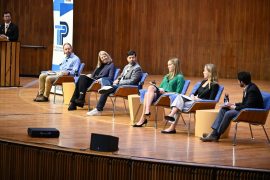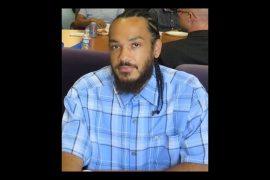Popular new major blends technical skills and human-centered applications

Combining computer science, data science, and economics, Course 6-14 prepares students to address thorny quandaries in many fields.
Annie Snyder wasn’t sure what she wanted to major in when she arrived on campus. She drifted toward MIT’s most popular major, electrical engineering and computer science (EECS), also known as Course 6, but it didn’t feel like quite the right fit. She was interested in computer science but more passionate about understanding how technology affects people’s everyday lives.
Snyder, now a junior, found a compelling mix of technical skills and human-centered applications in the major 6-14: Computer Science, Economics, and Data Science, which was jointly launched by the computer science and economics departments in 2017.
The major 6-14 is a unique blend of computer science, data science, and economics. Students learn computing fundamentals, like programming and algorithms, and receive a multifaceted view of data science, from machine learning to econometrics. The major also covers economics concepts like game theory, incentives, and multiagent systems.
“The economics side of things fascinated me. It seemed like this interesting way to take these technical concepts that are really abstract, which I was familiar with through my math background, and apply them to people, society, and modeling human behavior,” Snyder says. “At the same time, computing is a tool that is going to permeate every field, so having that computing experience is a way to up your game, in a sense.”
Since its inception, Course 6-14 has attracted students with a diverse set of interests. About 40 students chose the major in 2017 and it has since grown to include 135 students, more than half of whom are women. The first cohort of computer science and economics “bilinguals” graduated last year. Students have followed a wide range of paths, including joining tech giants like Google and Microsoft, starting careers at finance and management consulting companies, working in logistics or data analytics, pursuing academic research, and more.
Economics and computing join forces
Computer science and economics have always had some overlap, but as more market exchanges take place in online systems, the fields have become inseparable. The decision to create the blended major 6-14 grew out of developing collaborations between faculty in both departments, as well as strong student interest in the increasingly intertwined disciplines, says Asu Ozdaglar, head of the Department of Electrical Engineering and Computer Science and deputy dean of academics of the Schwarzman College of Computing, who helped oversee the launch of the new major.
Faculty members wanted to blend the fields in a way that would inspire and empower students, she says. Course 6-14 majors learn a variety of mathematical skills, but they also acquire hands-on experience in empirical analysis of data to uncover and solve real-world problems.
“The combination of topics and skills that 6-14 offers is not just useful for scholars intending to specialize at this exciting interface. The job market for our undergraduates has long valued exactly this combination of skills, as jobs in computer science and data science increasingly value knowledge of economic analysis, while job opportunities in economics, management consulting, and finance now often demand not just mathematical maturity but strong computational, algorithmic, and statistical expertise,” says Ozdaglar.
From the classroom to the real world
Computer science and data science provide tools for problem solving, and economics applies those tools to domains where there is rapidly growing intellectual, scholarly, and commercial interest, says David Autor, the Ford Professor of Economics, who helped launch Course 6-14.
He expects demand for graduates with skills in both disciplines will continue increasing, especially as more economic activity moves online. Companies large and small will need employees who can design platforms, think about incentives, and interpret large amounts of behavioral data.
Autor also hopes that the major 6-14 will raise awareness of economics at MIT and showcase that the field is a formal science with a widely useful toolset.
“Economics teaches people to think about social science problems analytically, in a very compelling and constructive way. Some of those problems are in ecommerce and data analysis, but some of those problems are in economic development, or social insurance programs, or climate science. The value of economics is that it provides a toolkit for applying the same kind of analytical thinking someone would to an engineering or computer science problem to these problems that greatly shape our world,” he says.
Preparing computing ‘bilinguals’
Senior Ali Sinan Kaya leveraged the skills he’s developed in Course 6-14 to land internships and research opportunities that will give him a leg up in his future career. He recently completed a UROP (Undergraduate Research Opportunities Program) at the MIT Sloan School of Management that involved testing an optimization algorithm for an online retailer.
The company offers services like assembly and insurance to customers who purchase furniture online. Kaya and his collaborators found that the way those services are displayed on the website has a huge impact on purchasing behavior.
“[Course] 6-14 gave me a good foundation that I was able to use when interviewing for these positions, to secure these internships,” he says. “Economics, computer science, data science, and mathematics — at the intersection of these fields, you have a successful data scientist. I don’t consider myself a successful data scientist yet, but I think 6-14 has really given me a foundation to become a successful data scientist.”
Kaya plans to embark on a corporate career to better understand how the economy works. In the long term, he hopes to apply those lessons as a politician or policy expert in his native Turkey.
“I want to use all this knowledge and these experiences to hopefully bring about change within my community,” he says.
For Ozdaglar, it has been especially rewarding to see students like Kaya master both skill sets in an effort to do important work in the world.
“It has been amazing to help develop a program that educates students at this exciting intersection. We never viewed this as just putting curricula together across two departments. Rather, Course 6-14 combines the strengths of the two disciplines to offer unique classes and opportunities for our students. It provides such a strong foundation that students are able to address deep problems that require a mastery of both of these disciplines. It has been wonderful to see this new generation of computing ‘bilinguals’ who will be able to make great contributions,” she says.


